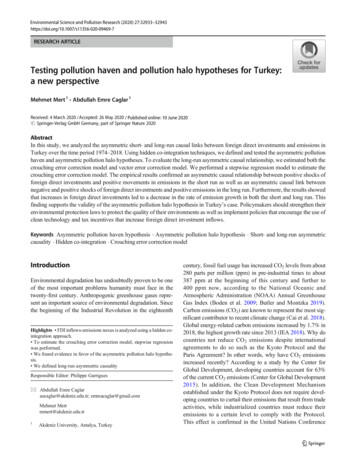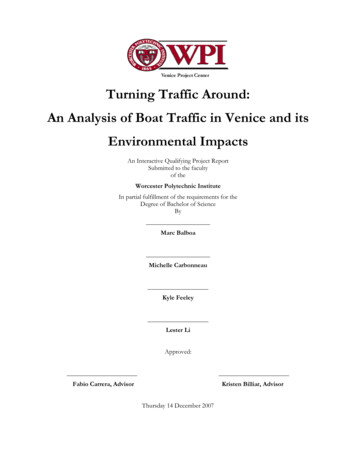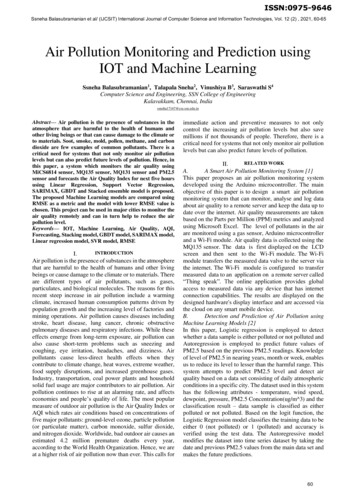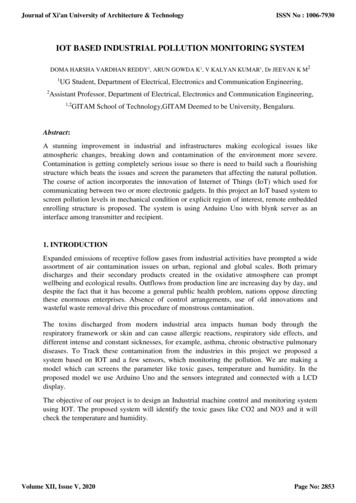
Transcription
Environmental Science and Pollution Research (2020) -09469-7RESEARCH ARTICLETesting pollution haven and pollution halo hypotheses for Turkey:a new perspectiveMehmet Mert 1 & Abdullah Emre Caglar 1Received: 4 March 2020 / Accepted: 26 May 2020 / Published online: 10 June 2020# Springer-Verlag GmbH Germany, part of Springer Nature 2020AbstractIn this study, we analyzed the asymmetric short- and long-run causal links between foreign direct investments and emissions inTurkey over the time period 1974–2018. Using hidden co-integration techniques, we defined and tested the asymmetric pollutionhaven and asymmetric pollution halo hypotheses. To evaluate the long-run asymmetric causal relationship, we estimated both thecrouching error correction model and vector error correction model. We performed a stepwise regression model to estimate thecrouching error correction model. The empirical results confirmed an asymmetric causal relationship between positive shocks offoreign direct investments and positive movements in emissions in the short run as well as an asymmetric causal link betweennegative and positive shocks of foreign direct investments and positive emissions in the long run. Furthermore, the results showedthat increases in foreign direct investments led to a decrease in the rate of emission growth in both the short and long run. Thisfinding supports the validity of the asymmetric pollution halo hypothesis in Turkey’s case. Policymakers should strengthen theirenvironmental protection laws to protect the quality of their environments as well as implement policies that encourage the use ofclean technology and tax incentives that increase foreign direct investment inflows.Keywords Asymmetric pollution haven hypothesis . Asymmetric pollution halo hypothesis . Short- and long-run asymmetriccausality . Hidden co-integration . Crouching error correction modelIntroductionEnvironmental degradation has undoubtedly proven to be oneof the most important problems humanity must face in thetwenty-first century. Anthropogenic greenhouse gases represent an important source of environmental degradation. Sincethe beginning of the Industrial Revolution in the eighteenthHighlights FDI inflows-emissions nexus is analyzed using a hidden cointegration approach. To estimate the crouching error correction model, stepwise regressionwas performed. We found evidence in favor of the asymmetric pollution halo hypothesis. We defined long-run asymmetric causalityResponsible Editor: Philippe Garrigues* Abdullah Emre Caglaraecaglar@akdeniz.edu.tr; emreacaglar@gmail.comMehmet Mertmmert@akdeniz.edu.tr1Akdeniz University, Antalya, Turkeycentury, fossil fuel usage has increased CO2 levels from about280 parts per million (ppm) in pre-industrial times to about387 ppm at the beginning of this century and further to400 ppm now, according to the National Oceanic andAtmospheric Administration (NOAA) Annual GreenhouseGas Index (Boden et al. 2009; Butler and Montzka 2019).Carbon emissions (CO2) are known to represent the most significant contributor to recent climate change (Cai et al. 2018).Global energy-related carbon emissions increased by 1.7% in2018, the highest growth rate since 2013 (IEA 2018). Why docountries not reduce CO2 emissions despite internationalagreements to do so such as the Kyoto Protocol and theParis Agreement? In other words, why have CO2 emissionsincreased recently? According to a study by the Center forGlobal Development, developing countries account for 63%of the current CO2 emissions (Center for Global Development2015). In addition, the Clean Development Mechanismestablished under the Kyoto Protocol does not require developing countries to curtail their emissions that result from tradeactivities, while industrialized countries must reduce theiremissions to a certain level to comply with the Protocol.This effect is confirmed in the United Nations Conference
32934on Trade and Development (UNCTAD) 2019 report, whichstated that “annual carbon emissions have accelerated in developing countries and have stabilized in developed countries” (UNCTAD 2019).The Kyoto Protocol drew attention to trade activities indeveloping countries, which view foreign direct investment(FDI) as an important strategy for economic growth. FDI inflows to the developing countries have increased, especially inthe last three decades, due to increased globalization and thefree movement of capital. Developing countries cannot allocate sufficient resources to investments that will contribute toeconomic development to achieve their growth targets.Therefore, FDI can provide some of the resources required.FDI can assist in a country’s development through technologytransfer, improved productivity, new management skills, andinfrastructure developments. Although FDI contributes toeconomic growth in the host country, it also raises controversyabout environmental quality. The environmental economicsliterature approaches this question through two opposing hypotheses. The first, the pollution haven hypothesis, states thatpollution-intensive production activities are directed from developed countries to those with more lax environmental regulations through FDI. Thus, developed economies reduce thecosts of adapting to environmental regulations and benefitfrom a cheap labor force. The other hypothesis, known asthe pollution halo hypothesis, claims that companies fromthe investing developed countries contribute to the hostcountry’s reduction of emissions because their productionstructure relies on green technology, unlike the host country’sexisting production.Since the second half of the twentieth century, developedcountries have imported many products from developingcountries and in this way exported their CO2 emissions tothe developing countries (Peters and Hertwich 2008).Developed economies ultimately seek to keep the global temperature rise below 2 C. Thus, the developed countries transferred 16 Gt CO2 emissions to the developing countries between 1990 and 2008 through international trade (Peters et al.2011). In Turkey, a developing country, both CO2 emissionsand FDI inflows increased during the same period (WorldBank 2019). The EY Attractiveness Survey Europe 2019named Turkey Europe’s 7th most popular international investment destination in 2018. FDI in Turkey increased 209 billiondollars, more than tenfold the original amount, between theyears 2003 and 2018 (Central Bank of the Republic of Turkey2019). BP (2019) confirms that Turkey emitted 209.9 milliontons of CO2 in 2003, which had increased to 389.9 milliontons by 2018. Turkey seems to be quite far from their emissiontargets in both the Kyoto Protocol and the Paris Agreement.Turkey’s capability to reduce their CO2 emissions will alsoplay an important role in their EU membership process. Thus,deeply investigating the effect of FDI on CO2 emissions isessential for Turkish policymakers. Therefore, we believe thatEnviron Sci Pollut Res (2020) 27:32933–32943use of advanced econometric techniques to investigate theeffect of FDI on CO2 emissions in Turkey not only assists inguiding Turkey’s environmental policy but also provides animportant contribution to the environmental economics literature as a whole.This study examines the asymmetric impact of FDI onTurkey’s CO2 emissions between the years 1974 and 2018.In this context, this study aims mainly to asymmetrically analyze the relationship between FDI and CO2 emissions in theshort as well as long run, as opposed to the existing literaturewhich examines these links symmetrically, as both FDI andCO2 can react differently to random shocks. For example, anegative shock in a host country may cause some companiesto believe that the situation is temporary, deciding to maintaintheir position and continue their investments in that country.However, some companies do not want to take the risks associated with the negative situation and may withdraw theirinvestments. Similarly, emissions can increase or decreasedue to shocks. For instance, while some countries choose torestrict emissions through protective policies, others avoidserious measures due to economic losses from negativeshocks. Therefore, analyzing each of these variables’ disparatereactions to positive versus negative shocks strengthens thevalidity of the research. In this context, our study distinguishesthe asymmetric effects of shocks on the short- and long-termrelationships between the variables.To the best of our knowledge, the pollution halo/havenhypotheses have only been tested symmetrically. However,negative and the positive shocks can affect pollution differently. With this in mind, we obtained the negative and the positive cumulative shocks of FDI and CO2 emissions for Turkey.After analyzing short-run asymmetric causality by using thenegative and positive cumulative shocks, we performed hidden co-integration techniques drawn from Granger and Yoon(2002), and Hatemi-J and Irandost (2012) to test the asymmetric pollution halo and haven hypotheses in Turkey. The hidden co-integration methodology allows researchers to evaluate relationships between the positive and negative cumulativeshocks of the series. The hidden co-integration procedure usesthe cumulative shocks of the variables to allow estimation oflong-run asymmetric relationships between the series. By estimating the crouching error correction model (CECM) afterperforming Granger and Yoon’s (2002) hidden co-integrationtest and the vector error correction model (VECM) afterperforming Hatemi-J and Irandost(2012) hidden cointegration test, we estimated the short-run relationships between the cumulative positive and negative shocks of the variables. Furthermore, we defined the long-run asymmetric causality between the variables based on the error correctionmodels.This study contributes to the literature in the followingways: firstly, by asymmetrically testing both the pollutionhalo and haven hypotheses. Secondly, it investigates the
Environ Sci Pollut Res (2020) 27:32933–32943long-run asymmetric causality through the estimation of theerror correction model. Finally, it proposes stepwise regression to estimate the CECM drawn from Mert and Caglar’s(2019) study. An examination of the literature reveals thatno more than four lags are usually incorporated in thecrouching error correction model as it is too computationallyintensive to add more (see Honarvar 2009; Alom and Ritson2012; Alexakis et al. 2013; Koutroulis et al. 2016). However,the crouching error correction model may possess more than 4lags. This discrepancy may lead to omitted variable bias in thestudies. To correct for such bias, we thus suggest stepwiseregression to select the lags in the crouching error correctionmodel initially proposed by Mert and Caglar (2019), thusproviding a methodological contribution to the literature. Inthis way, this study provides a new perspective in the ongoingdebate about the FDI-emission relationship.The next section of the study presents a review of the current literature on the pollution haven and pollution halo hypotheses. “Data and methods” describes the data and econometric methodology of the study. “Findings” presents empirical findings, and “Discussion” concludes the study.Literature reviewThe relationship between environmental degradation and FDIinflows has become a popular topic of discussion in environmental economics. The current literature presents two opposing hypotheses examining the impact of FDI on environmental degradation. The first, the well-known pollution havenhypothesis, posits that global companies outsource pollutionintensive industries to countries with cheap labor and lax environmental regulations. These countries, which do not possess the resources necessary for economic development, instead depend on external investments. They rely on legislativeincentives to encourage FDI. This hypothesis is partially explained by Grossman and Krueger’s (1991) scale effect, whichpostulates that countries need more natural resources and inputs in the first stage of economic growth. Thus, FDI-ledgrowth in the first stage of economic development should leadto more environmental pollution. Zhang and Zhou (2016)found that FDI inflows could enhance the host country’s economic activities, which triggers an increase in environmentalpollution if the lax regulations of the host countries are notchanged. On the contrary, the pollution halo hypothesis positsthat multinational companies transfer new production processes, management skills, and greener technologies to the hostcountry by complying with the international environmentalstandard framework, thus contributing to a reduction in carbonemissions of the host country.An examination of the current literature investigating theeffect of FDI on environmental degradation reveals the importance of country selection in the studies. While some studies32935consider individual countries, others analyze country groups.Shahbaz’s (2015) work serves as a pioneer for the literature onthe FDI-emission links; as previous work had proven that thisrelationship changes by country groups (i.e., low, middle, andupper countries, etc.), his study demonstrated the pollutionhaven hypothesis is more strongly supported in low- andmiddle-income countries, while the pollution halo hypothesisappears more valid in high-income countries. Table 1 presentsa summary of several studies that investigated whether FDIcauses environmental pollution in the host country throughvarious econometric methods.Contradictory views frequently occur in the literature, especially in studies that focus on FDI and environmental pollution.While some studies support the pollution haven hypothesis(Akbostancı et al. 2007; Kivyiro and Arminen (2014); Sekeret al. 2015; Solarin et al. 2017; Gorus and Aslan 2019; Caglar2020), others find stronger evidence for the pollution halo hypothesis (Hao and Liu 2015; Mert and Boluk 2016; Rafindadiet al. 2018; Balsalobre-Lorente et al. 2019). In addition, somestudies (Lee 2013; Shaari et al. 2014) demonstrate that the neutrality hypothesis is more appropriate for explaining the relationship between these two variables. Studies examining the FDIemission link in Turkey employ both the standard ARDL and theJohansen and Maki structural breaks co-integration tests. Table 1shows that the pollution haven hypothesis is more strongly supported in all the studies focusing on Turkey except in Ozturk andOz (2016). In general, criteria such as country selection, datalength, and econometric method play a key role in the differencein results. The FDI-emission literature relies most frequently onco-integration and causality analysis such as ARDL cointegration and Granger causality. Our study examines theshort- and long-term asymmetric causality for the FDI-CO2 emission relationship in Turkey. We use the Hatemi-J (2012) asymmetric causality test for short-term analysis, while we employboth the Granger and Yoon (2002) and Hatemi-J and Irandost(2012) hidden co-integration approaches, which, to the best ofour knowledge, have not yet been used in the relevant literature,for long-term causality.Data and methodsWe obtained the 1974–2018 time series of carbon dioxide(CO2) emissions (metric tons per capita) from BP statisticsand the net foreign direct investment (current US ) series(FDI) from the World Bank online database over the sametime period. We used different data sources for each seriessince the series FDI was available on World Bank databaseuntil 2018, but its emission series only ran until 2014. Weused the natural logarithms of both series for analysis. Toobtain the natural logarithm of the FDI series, we added aconstant value to the series so that all its values were positive.
32936Table 1Environ Sci Pollut Res (2020) 27:32933–32943Summary of FDI-emissions nexus empirical studiesReferenceLocationCategory A: time series papersSolarin et al.Ghana(2017)Rana and Sharma India(2019)Sun et al. (2017)ChinaTang and TanVietnam(2015)Shahbaz et al.France(2018)Lau et hat a 1%increase in the positive shocks of the foreign direct investments will decrease the positive shocks of emissions by0.221%. In other words, the positive improvements in theforeign direct investments will lead to a decrease in emissionincrease. This result supports the validity of the asymmetric
Environ Sci Pollut Res (2020) 27:32933–32943Table 532939Short-run asymmetric causality resultsHJ testBootstrap critical valuesDirectionFDIþ COþ2FDI CO 2FDIþ CO 2FDI .090CausalityYesNoNoNo means that there is no asymmetric causality. Bootstrap critical values are obtained based on 10,000 replications. Max. lag values are chosen accordingto AIC*Significant at .05 levelpollution halo hypothesis in Turkey, confirming that FDI inflows contribute to Turkey’s emissions targets. Policymakerswho focus on environmental standards should thus encouragemore investors to invest in Turkey through economic incentives such as tax breaks.To estimate the CECM, Eqs. 7 and 8 can be derived asbelow (Granger and Yoon 2002):ΔCOþεt 1 þ ki¼1 ψi ΔFDIþ2t ¼ ψ0 þ ψ1bt iþ pj¼1 ψ j ΔCOþ2t j þ υtð7ÞΔFDIþεt 1 þ ki¼1 γ i ΔFDIþt ¼ γ 0 þ γ 1bt iþ pj¼1 γ j ΔCOþ2t j þ vtð8ÞIn Eqs. 7 and 8, bεt 1 represents the one-lagged residuals ofthe estimated long-run equation in Table 6. The coefficientsψ1 and γ1 represent the long-run adjustments, while the coefficients of the lagged differenced variables stand for the shortrun adjustments. Many studies, like Granger and Yoon (2002)and Honarvar (2009), only report the significant coef
Testing pollution haven and pollution halo hypotheses for Turkey: a new perspective Mehmet Mert1 & Abdullah Emre Caglar1 Received: 4 March 2020 /Accepted: 26 May 2020 # Springer-Verlag GmbH Germany, part of Springer Nature 2020 Abstract










